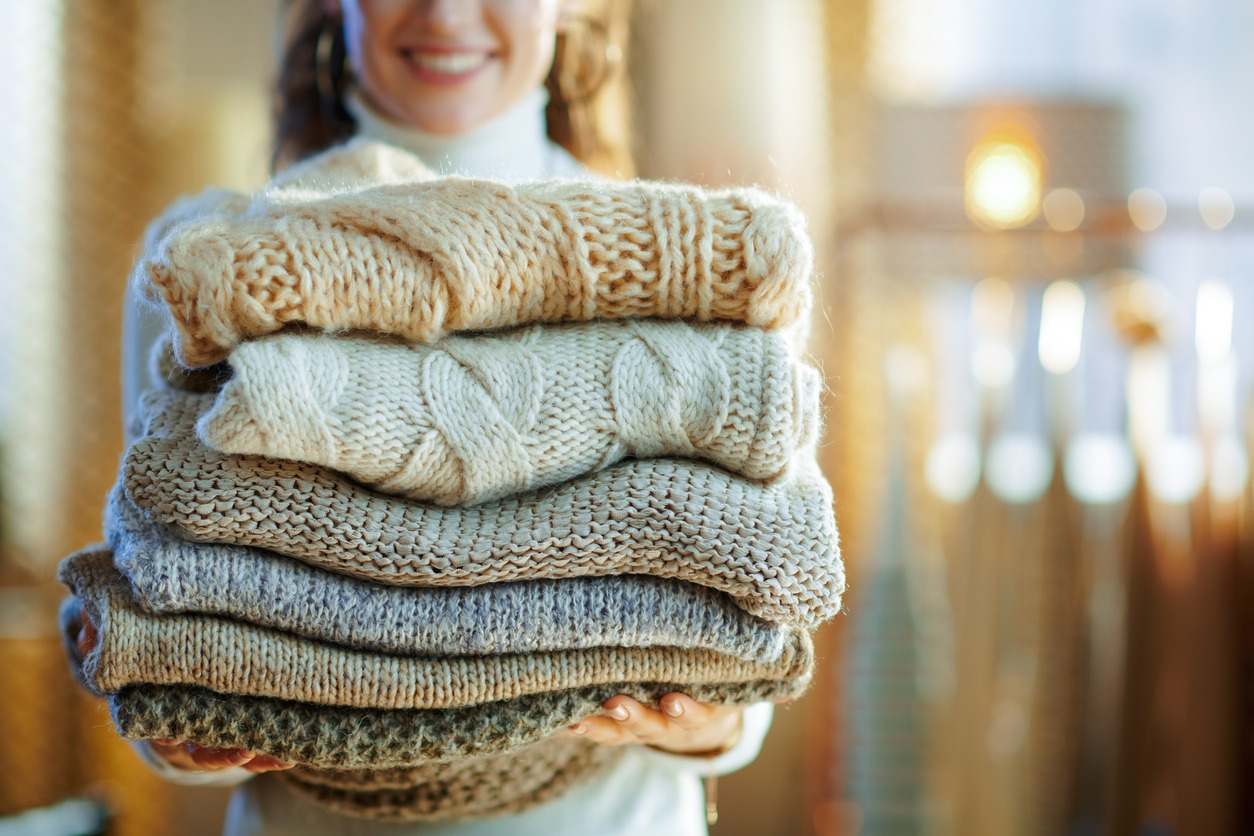The luxurious connotations of cashmere predate to Victorian days when the British began exporting it back home and to America and the rest of Europe. We may not appreciate its sense of opulence and luxury today, but it was unmistakably associated with the aristocracy and ruling classes back then. Of course, Queen Victoria wore it, thanks partly to a yearly gift of the finest cashmere from the Maharaja.
Cashmere is the best fabric to wear during the cold season: it’s natural, cozy, and warm, and you won’t want to take a cashmere piece off after wearing it – you’ll feel so cozy! Given how cold it is now, it’s high time to invest in a few cashmere pieces. Here’s a guide on how to wear and style cashmere.
History of Cashmere
Back then, the British saw the rest of the world as magical, exotic, and mysterious. This incredible fabric emerging from places only seen on maps was bound to bestow it with fairytale qualities.
But, like so many delicacies, it was new to nineteenth-century Britons because it had only recently been discovered. Locals from Northern India, China, Mongolia, Bhutan, Myanmar, and Nepal have known its exquisite qualities for millennia and have used and traded it for generations.
Its cashmere is derived from the Kashmir Valley, which grew into a larger region now governed by Pakistan, India, and China. The spelling is simply a Eurocentric way to present the information. It happens to be a useful way of distinguishing the region from the wool and the region, but it’s unlikely that anyone was thinking very far ahead when they labeled it.
Qualities of Cashmere

Along with its value and rarity, there had to be something else that gave it such luxurious connotations – after all, rarity does not always imply quality. Cashmere has three distinct qualities.
First and foremost, it is immaculately soft. Some sheep wool can be itchy, more so for some people than others, but no one ever complains about an unsettling cashmere sweater. You can wear it against your skin quite easily – in fact, cashmere underwear is available for those who enjoy the silky feel of cashmere.
Second, it has a warming effect. It’s the result of millions of years of evolution, and it’s uniquely tailored to keeping its original wearers (wild goats) warm and safe in some of the world’s harshest environments.
Even the most affluent households used to layer up indoors in the days before central heating. The invention of this light fabric as warm as wool and several times thicker, more comfortable, and less restricting on movement must have come as a surprise to its early adopters.
Third, cashmere is a durable and versatile fabric. Since it can be thinner than wool garments, it allows for more styling options for those who want to go above and beyond.
And, like silk, its luxe softness does not come at the expense of brittleness. Because cashmere is a durable fabric, don’t be amazed if your favorite sweater lasts for five to ten years.
Sweaters may be the first clothing that comes to mind when you think of cashmere, but it’s also used in scarves, blankets, dressing gowns, vests, gloves, and even highly opulent hot water bottle covers.
Different Types of Cashmere

Cashmere, like most fabrics, is graded according to its quality. It’s a good way to save money without losing the core of cashmere – for instance, a pure cashmere sweater may contain lower graded wool where it comes into contact with the skin less frequently.
Dual-layer knits with a lower grade outside and a higher grade inside are possible. It is visually indistinguishable and maintains its insulating properties but is less expensive. It’s similar to how high-quality furniture displays the most beautiful woods, but structural parts that never get seen can be made of tough timber without the finish and varnish of the visible.
The grades begin with Grade A, the best of the best, separated almost strand by strand from the grades below it. It’s difficult to find garments made entirely of Grade A cashmere because they would cost hundreds, if not thousands, of pounds and would harken back to the Victorian era of cashmere.
Grade B is the second-highest level of quality. It’s still good wool, but it’s nothing like Grade A. That means it can be sourced and prepared at a lower cost, making it a much more cost-effective use.
Then there’s Grade C. While it’s still much softer than sheep’s wool, it’s significantly less soft than the first two grades. It is just as warm as the other grades but would most likely be used in areas that do not contact the skin.
Several goat breeds produce cashmere, and their fibers are so similar that all but the most well-versed connoisseurs cannot tell them apart. The most well-known are Changthangi, Liaoning, Tibetan Plateau, Inner Mongolian, Zhongwei, Hexi, and Australian cashmere goats. All are excellent cashmere breeds, especially given the spinning, grading, treatment, cleaning, and weaving that occurs after shearing.
Merino wool is an alternative to cashmere. It is derived from merino sheep, not goats, and is valued for warmth, softness, and durability. It has a slightly different structure than cashmere, but it is softer and does not have the scratchy feel that lesser quality wool can have.
Given that most people would not pay a thousand pounds for a sweater, combining cashmere with some other materials helps keep them a reasonably priced luxury garment.
How to Wear and Style Cashmere
View this post on Instagram
Cashmere clothes, like woolen items, can be deemed winter garments, but this is not always the case. They’re light and breathable enough to wear into autumn and spring, but your can wear some items all year.
If it’s the warmth you’re looking for, it’s a personal preference – some people can handle the cold and the heat much better than others! You can always bring extra layers with you to add or remove as the weather changes.
You can wear a cashmere sweater (check out this sweater guide!) during formal situations, but a cardigan is more versatile and lighter when paired with business attire. It’s also better for displaying your neck jewelry if you enjoy wearing it.
Cashmere knitwear, on the other hand, is more casual. It’s warm and cozy, so it’s ideal for wearing outside or while socializing or shopping.
A cashmere tank top is also a great way to layer. Wear it with a long-sleeve tee or T-shirt for a more casual look, but pair it with canvas trousers or jeans and a loose casual blouse, and you’ve got that rustic look down to a tee – ideal for a stroll through the artisan market or a glass of wine at the restaurant.
Wearing Cashmere Sweaters
Cashmere provides warmth without the irritation that larger fibers can cause. Because it is lighter than standard wool, you can wear it beyond the sweater season. It’s also surprisingly versatile in terms of styling.
To demonstrate that last point, we chose different ways to wear cashmere and created day and night looks around them.
Cardigan
View this post on Instagram
Button-ups provide more structure—and a lot more leeway in terms of proportion. This produces an hourglass shape, and the roomy sleeves hold it from skewing too traditional.
Distressed denim gives this cardigan a tough-luxe vibe for a casual look. The sweater’s softness and the hue of its buttons are echoed in the shearling slippers.
To dress it up, pair it with a long skirt and a fluid silk cami with lots of movement to balance out the sweater’s curve-skimming shape. Dangling earrings complete the date-night look.
For more tips, here is a guide to wearing the cardigan.
Crewneck
Lightweight crewnecks are a year-round must-have. Their beauty lies in their simplicity; just put one on, and you can dress it up or down. Choose one that’s slightly cropped to show off your layers.
Wear the sweater with breezy joggers, a boxy tee, and sport sandals for a daytime look that’s ready for anything.
Layer the crewneck over a sharp button-up with an exaggerated collar for an evening-chic look. Tailored leather trousers are a bold choice that contrasts beautifully with the cashmere.
Turtleneck
Nothing is cozier than a turtleneck in the dead of winter. Turtlenecks are also timeless and flattering for everyone. Check the closets—you’ll find one in each one.
Pair this turtleneck with plush knit pants for a daytime look that’s high on texture and comfort. Warning: once you’ve arrived here, you won’t be able to remove this outfit.
For the evening, wear an A-line skirt in the same chocolate hue. The monochrome look amplifies the slouchy sweater, while the pleats in the skirt keep the look playful and loose.
How to Wear a Cashmere Scarf
View this post on Instagram
The greatest thing about cashmere scarves is that they are easy to style and can be worn in various ways.
By far, the most popular and one we see daily is to wear one casually across the shoulders with identical lengths on each side, referred to as The Drape – definitely a look that leans more towards style than function, but it will keep you warm.
However, if the temperature begins to fall, you’ll need to bundle up. This is where something like The Parisian Knot comes in handy, as it allows you to fasten it closer to the chin and keep the draught out.
It also looks good tucked inside an overcoat jacket collar or peace. Fold your scarf lengthwise in half. Drape the scarf around your neck, then pull the loose tails through the hole created by the looped end and tighten.
The Four in Hand is similar to the popular tie knot. It safeguards your neck from the elements in a similarly stylish manner as its cousin, The Parisian.
We hope this cashmere guide has inspired you to experiment with new looks and filled in any knowledge gaps you may have had about this great fabric. As you can see, it’s stylish, versatile, and so comfortable that once you’ve tried it, you’ll probably never go back to regular wool – and we’re here to help you embrace your newfound love.

